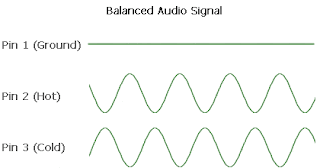A balanced audio signal is made up of three parts: one hot (also known as + or send) and one cold wire (also known as - or return), in turn surrounded by the ground wire. The ground is at zero volts, the hot wire contains positive voltages and the cold negative. In an ordinary single ended audio signal there's only two parts: one positive voltage and ground.
In order to work as intended, a single ended (unbalanced) signal must be converted into a balanced. This is done by splitting the signal in two, and let one part go through the hot wire while the other half is phase reversed into a negative mirror image before being sent into the cold wire. After passing through the balanced cable, the balanced signal is converted back in a common-mode rejection circuit (found in a mixer inputs or DI boxes), where the phase of the cold/negative signal is reversed back to normal (positive) before being mixed with the hot/positive signal. Since any noise picked up by the cable will have the same polarity in both the hot and cold signal wires it will cancel itself out when the cold/negative signal is phase reversed back and mixed with the hot/positive.
Balance XLR cable
Connecting balanced and unbalanced equipment
For a balanced cable to work as intended it must be connected between a "sender" circuit, that splits and phase reverses a single ended audio signal, and a "reciever" circuit that first switches the phase of the negative signal back to normal and then mixes it with the positive. If the signal entering a balanced cable is not balanced the cable itself can still be used (if you don't use a common-mode rejection circuit afterwards), but it will take up noise just like any ordinary cable. If an audio signal that's not balanced enters a common-mode rejection circuit (like in a DI box or mixer input) it will be cancelled out.
Balanc TRS (tip-ring-sleeve) or 1/4" cable
If you want to turn a balanced signal into an unbalanced without using a common-mode rejection circuit you can short the cold/negative signal to ground. The resulting audio signal will be a little weaker than normal as it's only made up of the positive signal half.
Got it!



No comments:
Post a Comment